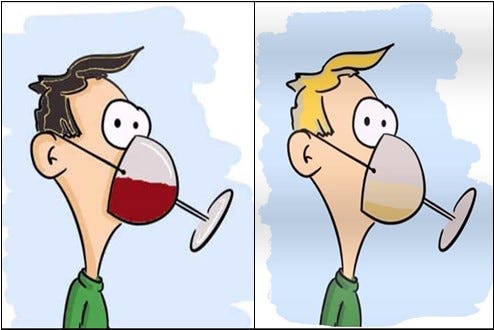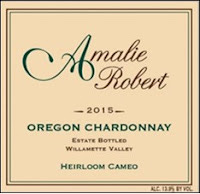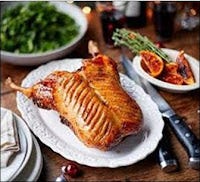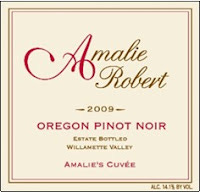Amalie Robert Estate Culinary Inclinations Series Part III: Roasted Whole Duck and Pinot Noir
Hello and Welcome,
This is the third segment in our Culinary Inclinations Series: Roasted Whole Duck and Pinot Noir. A FLOG communication (Farming bLOG) from Dena & Ernie @AmalieRobert Estate. Willamette Valley Oregon Pinot Noir. If you are anxiously awaiting the “Syrah and Lamb Love Chops” segment, it won’t be much longer.

Before we begin, we would like to wish everyone a very Happy Thanksgiving! The year 2020 has shown itself to be a very “interesting” year, and yet there is so much to be thankful for. Sometimes it is hard to see the vines through the dense fog that covers the vineyard. But we know that they are there, lying in wait ready to spring forth in vintage 2021 with a full arsenal of agrarian vagaries.
We are very much looking forward to a new year - a new growing season, and we hope you too are excited about the new opportunities that await us all. Or said another way, the unforeseen challenges we will most assuredly be forced to endure. Two sides of the same coin, it just comes down to your perspective. As farmers, we are always mindful that if anything can go wrong, it will, at the most inopportune time causing the most amount of trouble and expense. And yes, it is true, Murphy was a farming optimist.
For at least the next few minutes, we know what you will be doing. We don’t know where you will be doing it - Google has that covered. We appreciate you sharing some eyeball time with us. Kind of like looking into a window, us from this side and you from that side.

The holidays are upon us! We begin with Thanksgiving which is conveniently scheduled on the fourth Thursday of November. But it wasn’t always that way. You can read the full story at the National Archives. Or just follow along with the cliff notes here:
It all started back in the summer of ‘89 when the Federal Congress passed a resolution asking that the President of the United States recommend to the nation a day of thanksgiving. George Washington then proclaimed Thursday, November 26, 1789 as a "Day of Publick Thanksgivin". It wasn't until President Abraham Lincoln's 1863 Proclamation that Thanksgiving was regularly commemorated each year on the last Thursday of November.
In 1939, however, the last Thursday in November fell on the last day of the month. Concerned that the shortened Christmas shopping season might dampen the economic recovery, President Franklin D. Roosevelt issued a Presidential Proclamation moving Thanksgiving to the second to last Thursday of November. As a result of the proclamation, 32 states issued similar proclamations while 16 states refused to accept the change and proclaimed Thanksgiving to be the last Thursday in November. Dysfunction, it seems, was an inherent “feature” in our young republic and continues unabated to this very day.
Fixed it for you: To end the confusion, Congress decided to set a fixed-date for the holiday. On October 6, 1941, the House passed a joint resolution declaring the last Thursday in November to be the legal Thanksgiving Day. The Senate, however, amended the resolution establishing the holiday as the fourth Thursday, which would take into account those years when November has five Thursdays. The House agreed to the amendment, and President Roosevelt signed the resolution on December 26, 1941, thus establishing the fourth Thursday in November as the Federal Thanksgiving Day holiday. And if it works, stop fixing it.
Note that the very first government mandated Thanksgiving was on the 26th day of the month, just like this year. And similar to this year, the 1775–1782 North American smallpox epidemic was most likely still imparting a sense of caution. That was 7 years’ worth, and we are just now rounding the corner on our first year. Social distancing, quarantines and masks were tried then as now, the significant difference being in the quality of the masks. For our post-modern pandemic, we have both red wine AND white wine masks. The rosé mask is an easy farming work around.

So, there it is. Now lets’ get to the bird! Thanksgiving is a uniquely American holiday. And while there are just a handful of countries that do celebrate their own interpretations of Thanksgiving, EVERYBODY is on the Black Friday sales!
Ben Franklin, it is rumored, had originally wanted the Turkey to be the national symbol. He was “cancelled”, and the Bald Eagle became our national symbol. But in that defeat, there was a Thanksgiving victory. No one would have feasted upon the national bird at Thanksgiving.

Now there are all kinds of birds in our great land that can be the centerpiece of our Thanksgiving Day celebration. Let’s break them down into upland game birds and waterfowl. Upland game birds can be as small as Bobwhite quail weighing in at about 6 ounces. They get their name from their distinct call, which you can hear here.
Then we have partridge, guineafowl, all manner of grouse including the Ptarmigan, several variants of pheasant, and the varied species of turkey. There are several heritage breeds to choose from including the Auburn, Buff, Black, Bourbon Red, Narragansett, Royal Palm, Slate, Standard Bronze, and Midget White. Heritage turkeys represent about 25,000 birds raised each year, where there are close to 200 MILLION industry raised Broad-Breasted turkey. Check your local (or UPS serviced) terroir for availability.
There are about 7 million wild turkeys roaming our United States each year. Turkeys are not native to Oregon, but two species, the Merriam and Rio Grande were introduced in the 1960’s. And yes they can fly, in fact they roost in trees to avoid the ground based predators that are looking for their own Thanksgiving feast.

And we get them in the vineyard from time to time. They are tall enough to pluck off a wine berry or two. As you can see the turkey on the right has not had any Pinot Noir, but the turkey on the left has had quite enough to boldly display his full mating plumage! It’s the same old story, just a different species… And she is having none of it.
When it comes to fowl, and we mean waterfowl, the White Pekin duck reigns supreme for a Thanksgiving celebration. But there are also the Moulard and Muscovy farm raised ducks. A goose is another option, however it is more attuned to the Christmas holiday.

The origins of the phrase “You are full of it” is in fact attributed to the Christmas goose. Dressing is a dried bread-based concoction that includes all manner of vegetables, spices and quite often an egg or two to bind everything together. This mixture is then placed into a baking dish and put into a 350 degree oven for about an hour. When this mixture is stuffed into the cavity of a bird, such as a goose, it is known as stuffing. The full, olde English phrase is “You are as full of $#it as a Christmas goose!”
Penguinos range from the wee little Fairly Penguins of Australia and New Zealand that may grow to reach 12 inches tall to the imposing Emperor Penguins of Antarctica who tower at 4 feet or more. They are flightless water birds that are always dapper and dashing, however not included in the following preparatory guidelines. And then there is Opus T. Penguin…

Once you have decided upon the appropriate fowl for your Thanksgiving Day celebration, the next task before you is acquisition. There are several avenues available including instore shopping, curbside pick-up, UPS shipping and the tried and mostly true, full immersion duck hunting experience.
Unlike fishing, duck hunting is a serious endeavor that may, or may not yield results. Wild ducks are typically harvested when they are in flight. Not so different from fishing, as fish are usually harvested when swimming in the water. Same theory, just a different medium. The duck hunter's job is to encourage any given duck to land upon the Earth, or in a waterway that may or may not be frozen over. This requires the duck hunter to co-locate at least somewhat close to the in-flight duck, while fully enjoying all of the inclement wind, rain, snow, sleet and potentially freezing temperatures. Nice day today, not too hot…

There are several ways a duck hunter may encourage a flock of ducks to interrupt their migratory prerogative to land. Food is always a good encouragement as is an open waterway when their feet begin to freeze. Note: it is not uncommon for a duck hunter to lose feeling in their toes and fingertips. Duck calls are another inducement to land, especially if there are decoys in the near vicinity. Hey, is that a corn field? It looks like a party!
When these methods fail, there is the old school fallback of an ounce and a quarter of number 5 pellets with a muzzle velocity of approximately 1,350 feet per second. This form of encouragement can result in a single member of the flock to lose altitude rather suddenly. This is when the savvy duck hunter has a well-trained dog or has invited along a fellow sportsman with a well-trained dog. The lesson here is do not go duck hunting without a proper duck retrieval strategy. Or maybe you find a mid-November swim to be just a prelude to the annual Polar Bear plunge… And then there is the gestalt of ice fishing, but that is a misery best left for another time.
The other, more sane acquisition method involves the internet and an online visit to the Maple Leaf Farms website where you can arrange for your freshly harvested duck to land on your doorstep pre-plucked, disemboweled and ready to go. That maneuver just bought you enough time to enjoy a glass of wine by the crackling fire. A nice WARM crackling fire with the dog curled up at your feet. Toasty!
Culinary Inclination Series III: Roasted Whole Duck and Pinot Noir.
Are you a home chef, an involuntarily semi-retired chef or a chef waiting to re-open your restaurant? Not to worry, this easy step by step preparation and a little Pinot Noir will see you through in full plumage!
Prepare your roasting rack and preheat the oven: Line the bottom of the roasting pan with aluminum foil. Do not put foil over the top of the roasting rack as it will fill with very hot duck fat. This is a temporary or “fluid” situation, as liquified duck fat is subject to the laws of gravity and will, in short order, be on the floor. Or you, whichever it encounters first.
Besides, you are going to want to “harvest” that duck fat so you can scramble up some eggs for breakfast. Duck fat was Julia Child’s secret ingredient for all things savory. Sauté with olive oil during the week but live a little on the weekends and use duck fat.

Set the upper oven rack so that the duck when placed breastbone up will be below the upper element by about 2 to 3 inches. Preheat oven to 350 and sample the Pinot Noir to ensure proper temperature. For this portion of the preparation, a suitable Pinot in Pink Rosé or Heirloom Cameo BFC (Barrel Fermented Chardonnay) may be substituted with no loss of etiquette.
Note: The first step in this process will be to crisp the skin. This step will produce some smoke. We usually have a few windows open in the kitchen to keep us vented and eat in the dining room. Or, if wildfires are still raging in your area, you may not notice the smoke. Either way, you cannot make an omelet without breaking a few eggs. Nice shoes, by the way.
Preparing your duck and proofing the Pinot Noir: Remove the whole duck from its store (or natural) packaging as the case may be. Empty the body cavity and rinse thoroughly. If you plan to fill this cavity with stuffing, then a visual inspection is in order. Take a moment now to swirl your stem gently, but deliberately to observe how the wine catches the afternoon sunlight. Nice day today, not too hot...
Place the duck on a solid surface or cutting board, again breastbone up. Using a medium length, straight blade, score the skin on each side of the breast. Begin at the center of the breastbone and score diagonally upward toward the wing. Repeat with a parallel cut every 1 inch or so. Perform the same procedure on the other side. Be careful to not cut too deeply into the meat under the skin. Clip off the wing tips at the first joint.
The thighs are the fattiest portion of the duck and you will also score those. Turn the duck on its side and score vertically through the fatty portion of the thigh where it meets the back with 2 or 3 cuts. Again, do not cut so deeply that you cut into the meat. Repeat on the other side.

Finally, cut the skin and tendons at the end of the leg joint in a circular fashion. This will allow the skin and meat to rise up the leg bone toward the thigh and remain moist. This completes the knife skill portion of the preparation. Perform a standard finger count. The count should be 10, and if the count is in fact 10, then well done, it is time for a congratulatory sip!
Roasting with a convection oven: Place your scored duck on the roasting rack breastbone up. Spritz or brush with a light coating of sesame oil and season the scored breast with Hungarian paprika, Chinese 5 spice and finely cracked black pepper. Black sesame seeds are also an interesting textural addition.
Place the duck on the prepositioned upper-most rack in the preheated oven. Set the oven to BROIL and let this cook for 3 to 5 minutes. Put down the Pinot and keep an eye on things here as you will have duck fat and high heat in very close proximity.
The objective is to render the fat from the duck skin. This usually results in a deep golden-brown hue on the breast, but if you feel it is too much, take it out sooner. Remember there is a profound difference between a little char and burnt. Verify the remaining Pinot Noir bouquet is commensurate with the Duck. Secure a second bottle if necessary.
After you have crisped the skin to your satisfaction, remove the roasting rack from the oven and place it on a heat resistant surface. BE CAREFUL as the roasting pan will now have enough hot duck fat in it to give you a first hand impression of entering a medieval castle uninvited.
Set the oven to Convection Roast at 350 and move the rack to the center of the oven. Using appropriate tongs, turn the duck over so that the breastbone is now facing down and return the roasting rack to the oven. Toast your accomplishment with a sip of Pinot Noir, even if you must open that second bottle to do so.

Roast for about 45 minutes. The leg joint should move fairly freely when done. Remember that the breast meat is at its best medium to medium rare. Hmm, this second bottle is quite lovely. Ah, it is from the 2010 vintage, of course!
For the last 5 minutes of roasting, turn the duck once more so that the breastbone is facing upward. This will allow the fat to drain from the scored skin. Prepare your carvery area with the following tools: A large cutting board with a recessed fat drain, duck pliers (aka poultry shears), a very sharp boning knife and a hand towel. This will be your last chance for a sip of Pinot Noir for a little while, so make the most of it.

Presentation: Remove the duck from the oven and place it on the cutting board. Let stand, or sit, for about 5 (or maybe 10) minutes to allow the juices to cool. Keep an eye on the dog, retrieval skills are a natural instinct, and he has picked up the scent. Before the dismemberment begins, this is YOUR chance to shine. The kitchen is full of the most wonderful aromas of roast duck, sizzling duck fat and Pinot Noir. Your guests pass the carvery station and adorn you with accolades. With this high praise rolling in, now is NOT the time to run out of Pinot Noir.
Carving is the art of separating the meat from the supporting structure, known as the carcass. Legs and thighs are typically richer in texture. The breast meat, sliced thinly, glistens. Duck wing lollipops are the “Scooby-Doo snacks” that never seem to make it out of the kitchen. When everything is plated up, it is time to “Get the Duck Outta here!”
Duck is a very rich meat, so we enjoy a slightly bitter green vegetable such as garlic braised broccolini or Brussels sprouts in duck fat. Winter squash will pair with the sweetness of the meat. Of course, sautéed wild chanterelle or morel mushrooms are obligatory. The cheese course varies widely, however we recommend Fourme d’Ambert with whatever Pinot Noir is left after the meal, whether it IS open or IS YET TO BE open!
Please contact Dena by email at Cuvee@AmalieRobert.com or by phone at 503.88.CUVEE (28833) for pricing and availability of Amalie Robert Pinot Noirs, Heirloom Cameo Chardonnay and Pinot in Pink Rosé.
Happy Thanksgiving,
Dena & Ernie



